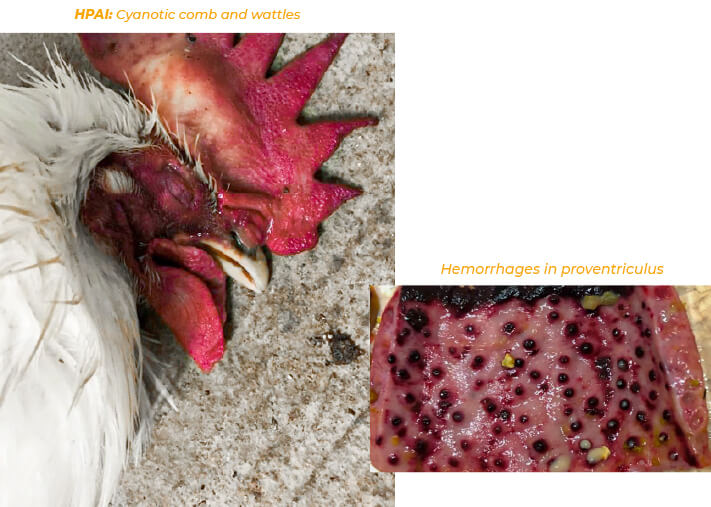For several years now, Avian Influenza has been a major concern for many countries in the world, primarily due to its disastrous effect on the poultry industry but also for their potential of causing human infections (certain strains).
It is caused by an Avian Influenza, a virus from the Orthomyxoviridae family.
These are Small-medium sized, enveloped single stranded RNA viruses, which have two major surface proteins, the Hemagglutinin (H1-H16) and the Neuraminidase (N1-N9), with 144 potential combinations.
The H and the N gives these viruses their names, like H5N1, H5N8 or H7N7.
The high variety of AI viruses is due to their potential to either mutate (antigenic drift) or to exchange genomic information if one host cell is infected with two different viruses (antigenic shift).

Infections with AI are notifiable to the World Organization for Animal Health (OIE) when they are caused by any Influenza A virus of the H5 or H7 subtypes.
Highly pathogenic notifiable avian influenza (HPNAI) viruses are (until now) H5 and H7 viruses which have an IVPI in 6-week-old chickens greater than 1.2 or have multiple basic amino acids at the cleavage site of the hemagglutinin molecule (HA0).
Infections with highly pathogenic influenza can cause up-to 100 % mortality in a few days after infection. The most predominant clinical signs are:

Diagnosis of Avian Influenza can be done by serology, but this could be used only to monitor infections with Low Pathogenic Avian Influenza (LPAI). Suspicions of Highly Pathogenic Avian Influenza must be immediately investigated by PCR.
Nowadays, Real-Time PCR is one of the most important tools in combatting Avian Influenza, as this allows diagnosis in a few hours with further confirmation by reference laboratories within 24 to 48 hours.
Table. Type A Influenza Surface Antigens



Natural Reservoirs for Type A Influenza Viruses include wild aquatic birds, the majority of which are represented by two orders:


But there are many other routes of transmission, like direct and indirect vectors, bird smuggling (e.g. roosters for cock fighting) or live bird markets. Humans are, after introduction via migratory birds, for sure to most considerable source of transmission.
Control of HPAI needs collaboration between all institutions involved, especially the poultry industry and government authorities.
Suspected cases need to be announced as quick as possible to avoid further spread of the virus.
Besides recommendations in the Terrestrial Animal Health Code of the OIE there is national and international legislation, like in Europe ‘Council Directive 2005/94/EC on community measures on the control of avian influenza’.
Control of NAI (Notifiable Avian Influenza) includes, for many countries, by the eradication of the virus via stamping out the infected populations. This is still the most effective way to control the disease but requires a network of diagnostic institutions (which should include private laboratories), readiness to implement the stamping out methods and safe disposal of carcasses.

There are active discussions about the use of vaccines.
Until now, inactivated vaccines have been developed, some using the DIVA principle (Differentiate Infected from Vaccinated Animals).
Other types of vaccines are also being developed; such as vector vaccines.
However, still as of today, none of these vaccines guarantee a “sterile” immunity in the field. In other words, avoiding any multiplication and further spread of the virus.However, still as of today, none of these vaccines guarantee a “sterile” immunity in the field. In other words, avoiding any multiplication and further spread of the virus.
Realtime PCR with QuantStudio 5 Cycler
Looking at international trade, vaccination is currently not accepted by many trade partners.
In order to allow further international trade in the presence of NAI cases Chapter 4.3 of the Terrestrial Animal Health Code describes zoning and compartmentalization as a procedure applied by a country in accordance with the provisions of this chapter for the definition of subpopulations with a specific health status within its territory for the purposes of disease control and/or international trade.


The term “zoning” (=regionalization) refers to a subpopulation of animals which are defined primarily geographically (by natural, artificial or legal boundaries).
The term “compartmentalization” refers to a subpopulation of animals which are primarily defined by management and animal husbandry practices related to biosecurity.
Achieving acceptance of regionalization, but even more with compartmentalization, requires an intensive cooperation between the poultry industry and government authorities.










 Veterinary
Veterinary 